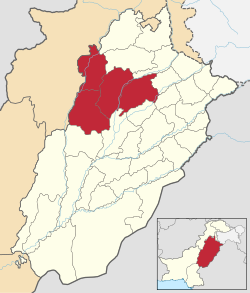Sargodha Division سرگودھا ڈویژن | |
|---|---|
 Sargodha Division in Punjab | |
| Coordinates: 32°10′N72°30′E / 32.167°N 72.500°E | |
| Country | |
| Province | |
| Capital | Sargodha |
| Established | 1960 |
| Districts | 4 |
| Government | |
| • Type | Divisional Administration |
| • Divisional Commissioner | Dr Irshad Ahmed |
| • Regional Police Officer | N/A |
| Area | |
| 26,360 km2 (10,180 sq mi) | |
| Elevation | 155 m (509 ft) |
| Population (2023) | |
| 9,591,275 | |
| • Density | 363.86/km2 (942.4/sq mi) |
| • Urban | 2,744,219 (28.61%) |
| • Rural | 6,847,056 |
| Literacy | |
| • Literacy rate |
|
| Time zone | UTC+5 (PST) |
| Postal code | 40100 (Sargodha) 41000 (Khushab) 41000 (Mianwali) 41000 (Bhakkar) |
| Dialling code | 048 (Sargodha) 0454 (Khushab) |
| Website | sargodhadivision |
Sargodha Division is an administrative division of the Punjab province of Pakistan. It includes the districts of Sargodha, Khushab, Mianwali and Bhakkar. The city of Sargodha is the capital of the division. Divisions are the third tier of government below the federal and provincial levels.
Contents
- Demographics
- Population
- Geography
- List of the Districts
- List of the Tehsils
- Constituencies
- Notable people
- See also
- References
In 2000, local government reforms abolished administrative divisions and raised the districts to the new third tier of government. [2] But in 2008, the division system was revived after the restoration of democratic government system. [3]
